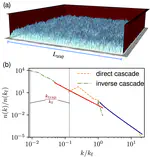Wave Turbulence Cascades in Bose Einstein Condensates made the Cover of PRL
A new paper about turbulent BEC
 The cover of PRL. The image shows a 2D cut of a turbulent BEC confined by a trap.
The cover of PRL. The image shows a 2D cut of a turbulent BEC confined by a trap.
In the mid-1920s, Bose and Einstein predicted that due to quantum mechanics, some atomic particles, since then known as bosons, could exhibit a quantum behaviour at a macroscopic level. Indeed, when a dilute gas of bosons is cooled down to temperatures close to absolute zero (-273C) an important fraction of the gas occupies the fundamental quantum state of the system. This peculiar state of matter is called a Bose-Einstein condensate (BEC). It took about 70 years to have the first experimental realisation of a BEC. Since then, they have become the subject of intense experimental and theoretical studies. In particular, over the last decade, the outstanding experimental control of Bose-Einstein condensates has permitted to drive them out of equilibrium by injecting and dissipating energy at different scales creating, in this way, well-controlled turbulent BECs.
In a turbulent BEC, due to the non-linearity, energy is transferred towards small scales by a cascade process analogously to classical hydrodynamic turbulence. In addition to energy, the number of particles at given scales also follows a turbulent cascade, but in the opposite direction, from small to large scales. These two cascades are known as the turbulent BEC’s direct and inverse cascades.
We performed a theoretical and numerical study of these BEC turbulent cascades. In particular, we revised and derived new analytical predictions for the Kolmogorov-Zakharov spectra, which are out-of-equilibrium solutions of the wave kinetic equation describing the system. Such predictions fix the scaling laws of the particle and energy distribution as a function of scales and also provide the exact value of the universal dimensionless physical constants. TWe then validate validated our theoretical predictions using high-resolution numerical simulations of the Gross-Pitaevskii equation, which describes BECs, and the associated Wave-Kinetic equation.
These new results explain previous unusual experimental observations of the direct cascade and suggest new inverse-cascade settings for future studies.
This work has been selected for the cover of Physical Review Letters Vol. 130, Iss. 13 — 31 March 2023
Learn more about the publication in:
